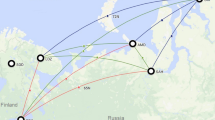Abstract
Variations in the parameters of the propagation of decameter waves on two auroral radio paths, Dikson–Pevek (D = 2800 km) and Lovozero–Pevek (D = 4200 km), were studied via oblique ionospheric sounding for two days, one weakly disturbed and one strongly disturbed. The following parameters were analyzed: F2 MOF and Es MOF (the maximum observed frequencies when the signal is reflected from the F2 layer and the Es layer), F2Spread (diffuse reflection), and lateral reflections. The following new results have been obtained: the F2 MOF level for the strongly disturbed day is higher than that for the weakly disturbed day on both paths; however, the F2 MOF values during substorms are either small or absent due to increased absorption. The Es MOF values on the Dikson–Pevek path increase during the period of disturbances. As for the Lovozero–Pevek path, the probability of Es reflections decreases during the disturbed day. The diffusion in the F2 layer on the Dikson–Pevek path is mostly typical for a strongly disturbed period, while that on the Lovozero–Pevek path, conversely, is mostly typical for weakly disturbed conditions. Lateral reflections on the Dikson–Pevek path occur rather rarely. On the Lovozero–Pevek path, there are very few lateral reflections on the weakly disturbed day and no lateral reflections on the strongly disturbed day.








Similar content being viewed by others
REFERENCES
Blagoveshchensky, D.V., Sergeeva, M.A., and Kozlovsky, A.V., Ionospheric parameters as the precursors of disturbed geomagnetic conditions, Adv. Space Res., 2017, vol. 60, pp. 2437–2451.
Davis, K., Ionospheric Radio, London: Peter Peregrinus Ltd., 1990.
Gershman, B.N., Kazimirovskii, E.S., Kokourov, V.D., and Chernobrovkina, N.A., Yavlenie F-rasseyaniya v ionosfere (The F-Scattering Phenomenon in the Ionosphere), Moscow: Nauka, 1984.
Goodman, J.M. and Ballard, J.W., An examination of elevated frequency propagation over a transpolar path, Radio Sci., vol. 39, no. 2, p. 204.
Hunsucker, R.D. and Hargreaves, J.K., The high-latitude ionosphere and its effects on radio propagation. Cambridge University Press, p. p. 2003.
Kishcha, P.V., Krasheninnikov, I.V., and Lukashkin, V.M., Simulation of the multifrequency propagation of shortwave signals in high latitudes, Geomagn. Aeron., 1993, vol. 33, no. 1, pp. 158–162.
Milan, S.E., Lester, M., Jones, T.B., and Warrington, E.M., Observation of the reduction in the available HF band on four high latitude paths during periods of geomagnetic disturbance, J. Atmos. Sol.-Terr. Phys., 1998, vol. 60, no. 4, pp. 617–629.
Razuvaev, O.I., Sporadic ionization in high-latitude geophysical research, Issled. Geomagn., Aeron. Fiz. Solntsa, 1991, no. 93, pp. 3–16.
Shubin, V.N. and Deminov, M.G., Global dynamic model of critical frequency of the ionospheric F2 layer, Geomagn. Aeron. (Engl. Transl.), 2019, vol. 59, no. 4, pp. 429–440.
Stocker, A.J., Warrington, E.M., and Jones, T.B., A comparison of observed and modeled deviations from the great circle direction for a 4490 km HF propagation path along the mid-latitude ionospheric trough, Radio Sci., 2003, vol. 38, no. 3. https://doi.org/10.1029/2002RS002RS002781
Vilella, C., Miralles, D., Altadill, D., Acosta, F., Solé, J.G., Torta, J.M., and Pijoan, J.L., Vertical and oblique ionospheric soundings over a very long multihop HF radio link from polar to midlatitudes: Results and relationships, Radio Sci., 2009, RS2014. https://doi.org/10.1029/2008RS004001
ACKNOWLEDGMENTS
The author is grateful to D.D. Rogov, the member of the Arctic and Antarctic Research Institute (AARI), St. Petersburg, for providing the OIS data owned by the institute. The author is also thankful for the opportunity to use data on the variations in the magnetic field H component and absorption from Tiksi station on the website of the Roshydromet Arctic and Antarctic Research Institute (AARI) (geophys.aari.ru). The author thanks the members of the Institute of Terrestrial Magnetism, Ionosphere and Radio Wave Propagation, V.N. Shubin and M.G. Deminov, for the permission to use their IRI + GDMF2 model.
Funding
This work was supported by the Russian Foundation for Basic Research, project no. 18-05-00343.
Author information
Authors and Affiliations
Corresponding author
Additional information
Translated by M. Chubarova
Rights and permissions
About this article
Cite this article
Blagoveshchenskii, D.V. Features of High-Frequency Radio Wave Propagation on Auroral Paths at Different Geomagnetic Activity. Geomagn. Aeron. 60, 335–344 (2020). https://doi.org/10.1134/S0016793220030020
Received:
Revised:
Accepted:
Published:
Issue Date:
DOI: https://doi.org/10.1134/S0016793220030020



